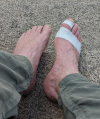Thanks
@dougfitz. The website is at blister-prevention.com these days.
Blisters continue to be *tricky* and what works for one doesn't work for another, for a very specific reason. That is, our (mainstream) understanding of what causes blisters is a bit off the mark. Most think it's friction (ie: rubbing) and so the solution must be stop things rubbing the foot. The opposite is true. Think about it, Vaseline works by making things slippery and rub more. Yet it can prevent blisters for a lot of people?
Friction's more scientific definition is the force that keeps surfaces stuck together (surfaces as in: skin-sock, sock-shoe, shoe-ground... high friction means they are grippy). It's not the rubbing on the skin that's important. But there is something moving relative to the skin surface that is important, and it's happening from within. It's the bones of the feet. The bones move back and forth with every step we take. Meanwhile, high friction levels keep the skin, sock, shoe and ground all stuck together (think traction). This is normal and a good thing for efficient walking (think about how inefficient it is to walk on a slippery floor without traction (low friction)). So the bones move and the skin doesn't and it's the job of all the soft tissue layers between skin surface and bone, which are all connected, to stretch and distort to allow for the mismatch in movement (between skin surface and bone).
So the relevant factors to blister formation are moving foot bones, high friction levels (which means grip and traction, which are good for efficient walking, until it gets too much), and the repetition (the more steps you take, the more likely blister formation is).
Back to rubbing - With any single rubbing action, there are 2 parts to it. The first is where there is no relative movement (no rubbing); the second is where there is relative movement (rubbing). The amount of shear is going to be determined by how long those two surfaces remain in stationary contact (ie: the no rubbing part). Make it slippery and shear deformation will be small (you'll be able to take more steps before the blister injury happens). Make it grippy and shear deformation will be big (more likely to get blisters sooner).
There's are nuances beyond this, but I thought this explanation might help a few people who are confused about the conflicting advice around blister prevention.






















